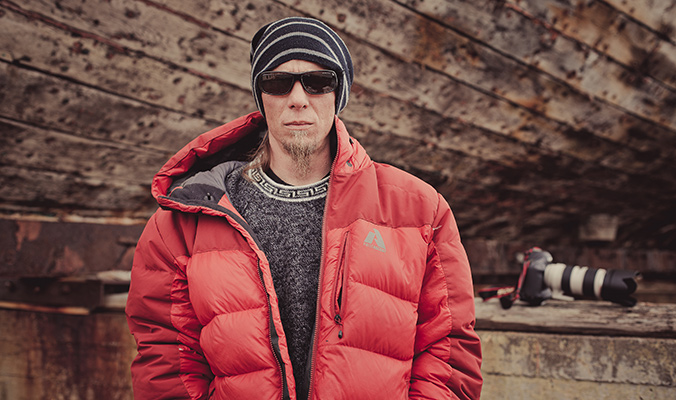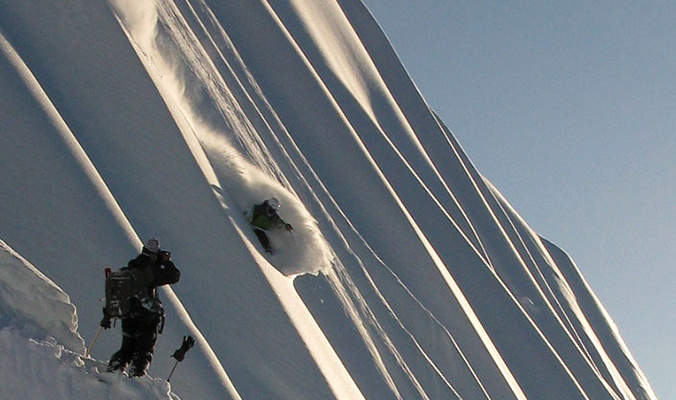Will Wissman has been taking pictures for longer than most people can say they have been skiing. A New Mexico native, Wissman moved to Alta in ’95 and shortly after began working with the snowmaking crew on the mountain. “To this day [it’s] been my favorite job,” he says. “I got to roll around in the mountains all night and watch the most amazing sunrises.” After a year, Wissman bought a Minolta camera and began taking it to the mountain. Since then, he’s worked with magazines like Backcountry, National Geographic Adventure and Outside, to name just a few. His latest endeavor, Stellar Media, works with film, written word and photography.
Wissman carved out time in his busy schedule to chat with Backcountry about snowmaking, stoke and how avalanches can save lives.

Home Mountains: Alta & Snowbird, Utah
Website: willwissman.com
Gear He Can’t Live Without: “My touring setup.”
Superpower: “Teleporting.”
[Photo] Christian Clavadetscher
Will Wissman: My love of skiing. I grew up in Santa Fe, New Mexico, and before I went to college I went to ski Alta for a year. That was 19 years ago now. My second year at Alta I got on a snowmaking crew. I was on the graveyard shift, so I would see the sunrise every morning, and just being up on the mountain watching the sunrise and the alpenglow motivated me to start capturing it.
BCM: What goes into making a great shot?
WW: I was a skier way before I was a photographer, so when I started to get serious about photography, what made a really good shot to me was a photo that really gave the viewer an idea of what the skier was up to. There is obviously lighting and angle and stuff like that, but all of that comes together to show the skier getting a good line. [A great shot] should stoke that skier side of me instead of just being a really nice photo.
I get most of my inspiration from my skiing. I also get a lot of inspiration from other photographers. It’s been cool switching from film to digital, and watching what other people are doing. There’s just more people doing stuff now, and it’s not necessarily how good your gear is, it’s about being out in the right place at the right time.
BCM: What are some defining moments in your photography career?WW: The most defining moment was really early in my career. I think it was ’97. I went to a tele comp in Crested Butte, and at that time I’d been published a few times, but it was still in a lot of ways a pipe dream to be a ski photographer. I was there to shoot photos, and at the start line a guy told me, “I’m going to go hit this jump if you want to take a picture of it.” So I shimmied my way down for a good angle on the air.
He hit the jump and submarined really bad. It was probably, a 50- or 60-foot cliff. I was standing on a ledge, and I jumped a 20-foot cliff down to him and dug him out. By the time I actually got him out of the snow he had stopped moving and wasn’t breathing. He had a full-face helmet on, and I was able to grab that and pull his head out of the snow. I had to put my fingers in his mouth to clear the ice. He started breathing again and got up out of the hole. We were both standing there looking down on the venue, and we could see two patrollers postholing trying to get up to where we were. It was clearly going to take them another 20 minutes. That was really a defining moment because I left that comp with the attitude that I was doing exactly what I needed to be doing. It was just way too clear that I needed to be on the mountain with my camera.
BCM: What’s the sketchiest experience you have ever gotten yourself into?
WW: Avalanches. Once I was buried to the neck, and the second time no one was buried, but we went for a pretty good ride, like 500 vertical feet. My friend was up on a ridge, and as I gained the ridge, both our weights got the slope to release. We came tumbling down on top of the two other guys that were still bootpacking up.
It was an early morning. We were trying to catch the sunrise light, kind of rushing. Only one of us should have been exposed to that slide, but since we were in a rush all four of us were exposed. That really changed my attitude. When you are trying to get photos, that whole Kodak courage, human factor stuff really complicates things, and that incident showed me that. You can’t let the camera dictate when you’re out there. In a lot of ways, I think that incident probably saved my life in the end.
BCM: Do you have any words for an aspiring photographer?
WW: If you are really passionate about what you are taking photos of, then that’s the best thing. You may be making money shooting weddings or something, but if there is something in your life that you are super passionate about that’s where a lot of a photographer’s success can come from. If you are super into something then you understand it really well, and you can do a better job of portraying it through your photos.











Related posts:
Snow Shooter: Bruno Long
Snow Shooter: Photographer Cody Downard
Snow Shooter: Jason Hummel
Snow Shooter: Tero Repo